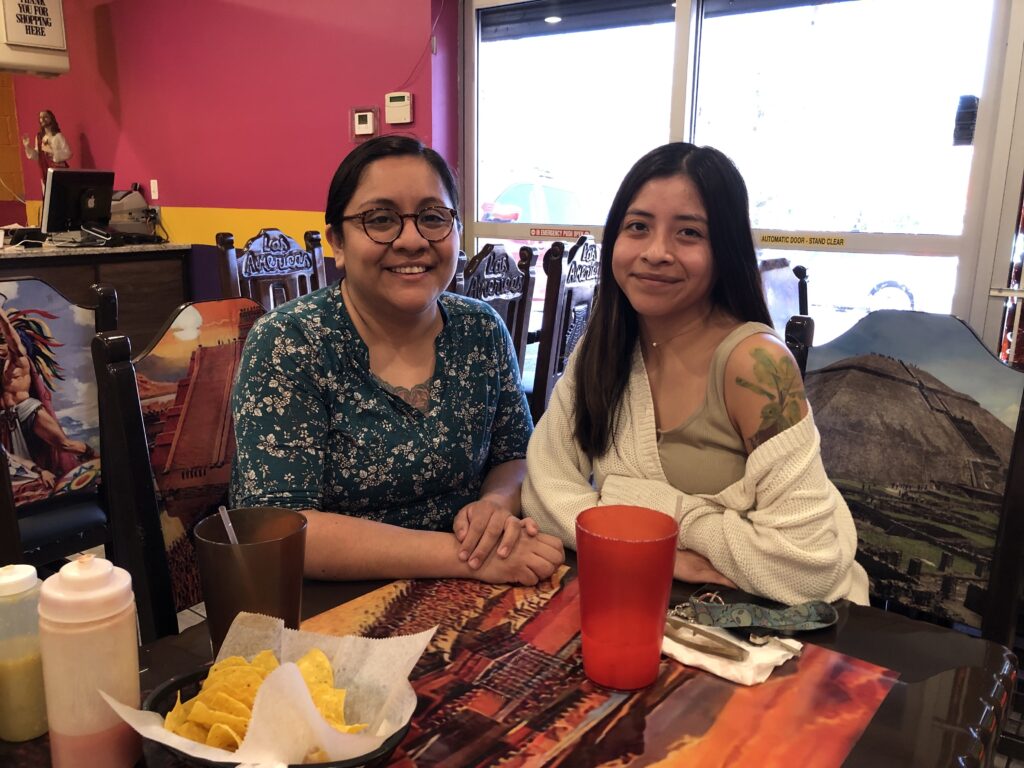
Lucy and her aunt, Leticia, sit across the table at Las Americas restaurant in South Nashville. The walls are painted a warm red and yellow, and nostalgic Mexican black-and-white movies play on the TV screen. Lucy’s family has been taking her here since she was a kid.
“I’ve ordered the same thing ever since then!” she said, laughing. “I was shown the pupusas one time, never changed.”
 Roland Tanglao Wikimedia Commons
Roland Tanglao Wikimedia CommonsPupusas, cornmeal flatbreads stuffed with meat and cheese, are a staple of Central American cuisine. They’re often served with marinated cabbage, called curtido. “It’s coleslaw,” Lucy said, laughing.
Pupusas are corn-flour flatbreads filled with meat and cheese. They’re a staple food in Central America, including Guatemala, where Lucy’s parents are from. Her dad’s an asylum seeker who got citizenship, but her mom is undocumented. (WPLN is only using her first name to protect her family’s identity.)
According to the Center for Migration Studies, a New York-based think tank, nearly 10 million U.S. citizens are part of a mixed-status family. That means they have at least one parent, sibling or spouse that’s undocumented. If President Donald Trump fulfills his promise of deporting every undocumented immigrant, these families would be separated.
Many of these families have just one way to prevent this: for the undocumented person to go to their home country, get a visa from the U.S. embassy there, and come back legally.
As Lucy ate lunch at Las Americas, her parents were in the middle of this process — they were in Guatemala, trying to get her mom a visa.
“‘You can be fearful all you want, that is totally, totally OK,'” Lucy remembers telling her mom before the trip. “‘You can be very, very excited as well.’ And, I’m like, ‘You can be anxious. You are totally allowed to have all these feelings.'”
Lucy’s mom had been trying to get a legal immigration status for years — not just because of the threat of deportation, but because being undocumented affected her ability to earn money for the family.
“She can’t have a normal job,” Lucy said. “She can’t have benefits. And she has had multiple times where, being paid under the table, people will basically steal her wages because of that.”
A risky journey
Not all undocumented immigrants qualify for the path Lucy’s mother took. Among those who do, many don’t attempt it. Emily Stotts, legal director of the nonprofit Tennessee Justice for Our Neighbors, says in her more than a decade as an immigration lawyer, she’s only had a handful of clients even try.
That’s partially because of the slow bureaucracy of the U.S. immigration system. Immigrants can wait years or even decades before they even find out if they’ve been approved. In addition, some are not able to afford the trip or the legal fees. The situation in their home country might be unsafe. And if there’s something wrong with their paperwork once they’re out of the country, they can be barred from re-entering the U.S. for up to 10 years.
“Obviously, if you have children here, if you have a life here, if you had a family here, that’s kind of the end of the conversation,” Stotts said. “A lot of people aren’t willing to risk that.”
For Lucy’s mother, the process was daunting. Spouses of U.S. citizens can get legal status — but if they’ve lived here without documentation for more than six months, they first need a waiver in which the government agrees not to punish them for the time they spent here illegally. Then, they need to get a visa at the U.S. embassy in their home country. Lucy thinks her mom may have finally got a waiver because her brother and sister were in the U.S. Marines.
“After my brother joined, he was able to help expedite her process,” Lucy said. “And within the last year, certain processes she’s never been able to reach before started happening for her.”
But Stotts says that’s probably not what happened. She says there’s usually no simple explanation for why some immigrants get a favorable outcome from the government, or why others don’t.
“I frequently tell clients: Just because you’re X, Y or Z does not mean that the government’s going to speed up your process for you,” Stotts said.
Family connections
Even as Lucy’s family works toward reunification with her mom, there are other relatives she’s worried about. Her mixed-status relatives are part of a tight-knit extended family in Cookeville, Tenn., where she grew up. Lucy’s grandmother, Ana, brought her family, including five sons and two daughters, from Guatemala to escape a civil war.
“They were abducting boys, and they were taking them and putting them in the guerrillas,” explained Leticia, Lucy’s aunt and Ana’s youngest child. “That’s what I’ve been told.”

Ana, Leticia’s mom and Lucy’s grandmother, was a leader in Cookeville, Tenn.’s Guatemalan community.
Ana soon became an advocate and a matriarch for Cookeville’s Guatemalan community.
“The Catholic Church in Cookeville was only in English at the time,” Leticia said. “So she made it a very important deal for everybody to be included and finally convinced the governing body over the church in Cookeville to start doing mass in Spanish. So a lot more people came out.”
Other Guatemalan immigrants would come to Ana for help adjusting to their new home.
“She’d teach them: ‘You go to the courthouse to do this. You go to pay rent here. You go to the bank to do this. You can go to the groceries here,'” Leticia said.
Leticia was born on U.S. soil, but her older siblings all arrived in this country as asylum seekers. Their asylum claims had mixed results. Two of Leticia’s brothers are now citizens, but one was deported and lives in Guatemala. One of her sisters got legal permanent residency, but doesn’t have the money to pursue citizenship. Leticia and Lucy also have undocumented relatives who are more recent arrivals to the U.S.
Leticia’s family situation is not unique. As a community matriarch, her mother helped many other mixed-status families like hers. Leticia estimates that “the vast majority” of Guatemalan families she knows have at least one undocumented member.
Reunited
For Lucy’s mom, returning to Guatemala paid off. A couple weeks after that lunch at Las Americas, Lucy received some happy news: Her mom was back in the U.S. legally — her family was reunited.
“Any pestering question that I had in the back of my mind, it all just disappeared,” Lucy said with tears in her eyes. “Because as soon as I was able to hold my mom, it felt like I’d never been given that strong hug in so long, and I did not want to let go.”
Now, her mother will begin the process of finding a better-paying job with benefits.
“From here now, it is just about living our lives as much as possible, enjoying each other, being here for our community,” Lucy said.
Meanwhile, the Trump administration’s immigration enforcement has gotten harsher and harder to predict. Stotts, the immigration lawyer, says she used to help clients who wanted to leave the U.S. to get visas. Now, she worries it’s too risky for any immigrant to travel internationally, for any reason.
“For my clients that are thinking about leaving the U.S., even though a lot of them have either residency or some other permission that says they’re allowed to leave and come back, I’m honestly cautioning them against it,” she said.
That means even fewer mixed-status families will attempt what Lucy’s mom did, leaving them vulnerable to separation.
Correction: This story previously stated that Ana, Leticia’s mother, had three daughters. She had two.

